How to Create Content for Google’s E-A-T Algorithm Update
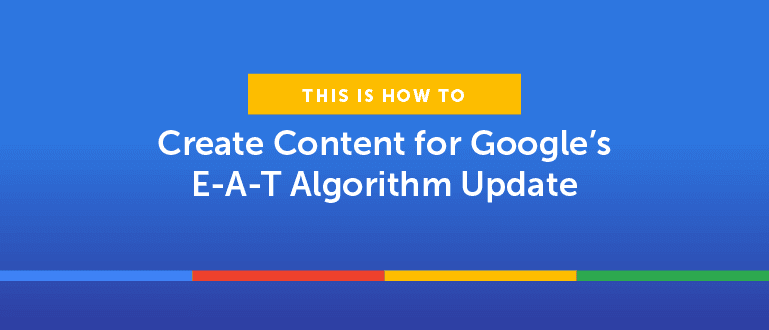 You already know that content marketing is a tough nut to crack--even if you’ve got the privilege of working with a team of people with a knack for words.
There’s blog posts everywhere you turn in your Google Drive, research papers littering your desk, and website content planned for the next six months. But even after all that prep, it’s still possible to sink to the bottom of Google’s search results.
Just 9% of content gets some form of organic traffic.
And it’s pretty easy to fall into the 91% that doesn’t--especially when over 3 million blog posts are being published every day.
You already know that content marketing is a tough nut to crack--even if you’ve got the privilege of working with a team of people with a knack for words.
There’s blog posts everywhere you turn in your Google Drive, research papers littering your desk, and website content planned for the next six months. But even after all that prep, it’s still possible to sink to the bottom of Google’s search results.
Just 9% of content gets some form of organic traffic.
And it’s pretty easy to fall into the 91% that doesn’t--especially when over 3 million blog posts are being published every day.
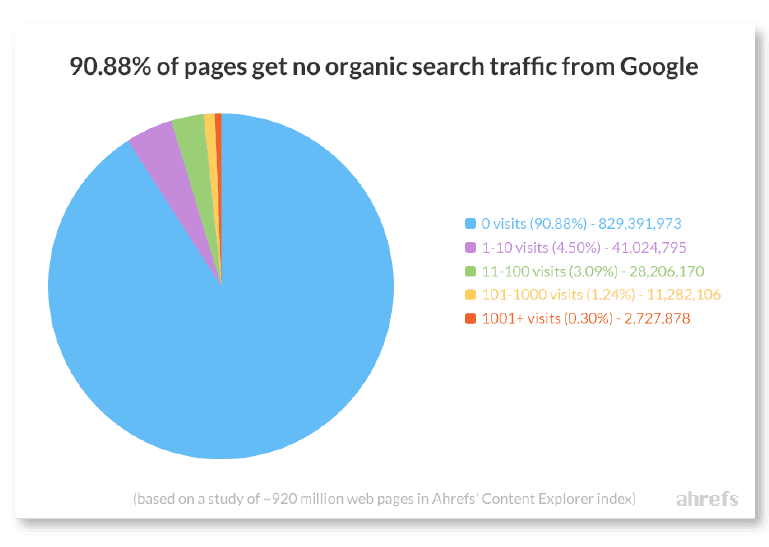 Pretty disheartening, right?
It doesn’t have to be that way forever. In fact, you could earn pride of place in Google’s SERPs by focusing on one of their new algorithm features: The E-A-T update.
Here’s how you can get in on the action.
Pretty disheartening, right?
It doesn’t have to be that way forever. In fact, you could earn pride of place in Google’s SERPs by focusing on one of their new algorithm features: The E-A-T update.
Here’s how you can get in on the action.
How to Create Content for Google’s E-A-T Algorithm Update by @elisedopson via @CoSchedule
Click To TweetWhere It All Started: The “Medic” Update
On Aug. 1, 2018, Google rolled out a new core algorithm update. That’s not groundbreaking news--they release some kind of update several times a year, as explained by the internet gods themselves:But this one? It was pretty spectacular. And I don’t just mean the sheer size of it--the effects were devastating for some websites. Huge sites like LiveStrong, The Kitchn and Men’s Health lost thousands of organic visitors overnight:As with any update, some sites may note drops or gains. There’s nothing wrong with pages that may now perform less well. Instead, it’s that changes to our systems are benefiting pages that were previously under-rewarded....
— Google SearchLiaison (@searchliaison) March 12, 2018
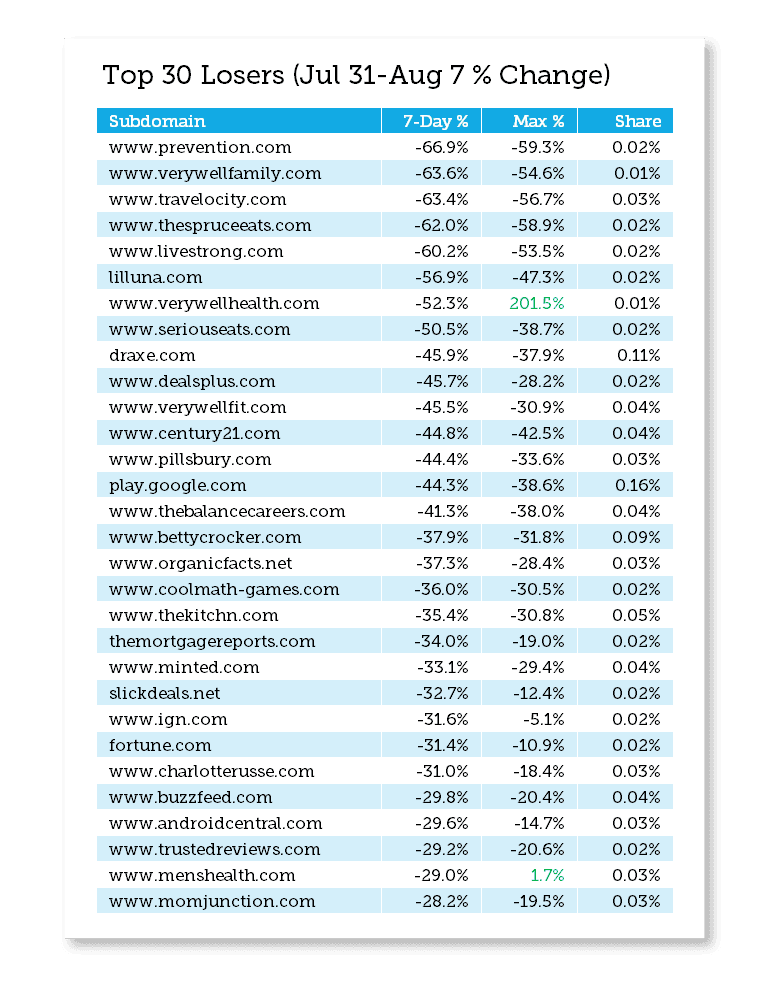 I think a 50%+ drop in organic traffic is significant enough to call this update a pretty big deal.
But if you had your spy goggles on while sieving through that data, you might’ve noticed a trend with the sites that took a hit.
Data collected by Search Engine Round Table found 41% of all sites affected by the update were in the healthcare niche--hence why you might’ve heard the algorithm named the “medic update”.
That’s not to say site owners who don’t fall into the healthcare category are safe though. In fact, eCommerce, business, technology and finance took a sizeable dent of the disaster share, too:
I think a 50%+ drop in organic traffic is significant enough to call this update a pretty big deal.
But if you had your spy goggles on while sieving through that data, you might’ve noticed a trend with the sites that took a hit.
Data collected by Search Engine Round Table found 41% of all sites affected by the update were in the healthcare niche--hence why you might’ve heard the algorithm named the “medic update”.
That’s not to say site owners who don’t fall into the healthcare category are safe though. In fact, eCommerce, business, technology and finance took a sizeable dent of the disaster share, too:

E-A-T Guidelines, Explained
If I’ve scared your socks off, I apologize. But the entire point of me talking about this is to show you how you don’t have to slip to the bottom of page 50 at the mercy of the medic update. In fact, you can use one of their revised ranking factors to your advantage with the content you’re creating. Part of the medic update consisted of Google’s guidelines to “create great content”. Here’s Google’s Public Search Liason, Danny Sullivan, explaining exactly that:Not really helpful, right? Especially if you’re already creating great content. (Which, spoiler alert: You should be.) But an interesting part of that whitepaper was Google’s focus on E-A-T content. Those guidelines refer to how Google measures the quality of a page. It stands for:We tell lots of things to do. Improve site speed. Consider secure. Etc. But that's not what this update was about. It's broad. And respectfully, I think telling people there's no particular thing to "fix" is indeed helpful. It means, hopefully, they think more broadly...
— Danny Sullivan (@dannysullivan) August 1, 2018
- Expertise: How knowledgeable is the site owner on the subject matter?
- Authoritativeness: How credible is the website publishing this content?
- Trustworthiness: How trustworthy is the website publishing this?
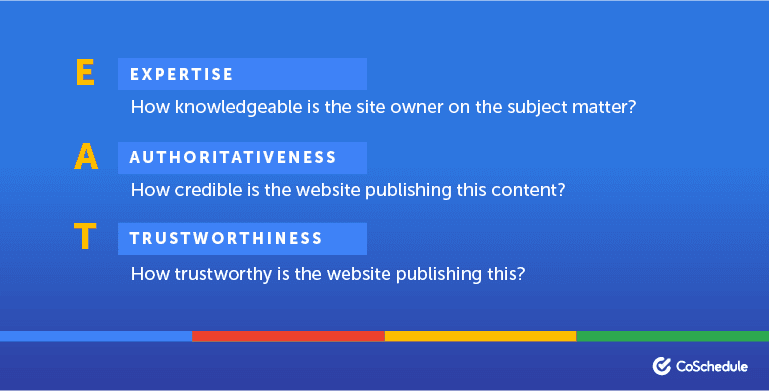 Searchers want to see the best content that satisfies our user intent. If that’s to view information, you’ve got no chance of ranking highly if you’re not factoring E-A-T guidelines into your content marketing strategy.
Searchers want to see the best content that satisfies our user intent. If that’s to view information, you’ve got no chance of ranking highly if you’re not factoring E-A-T guidelines into your content marketing strategy.
How to Create E-A-T Rich Content
Ready to make a dent in the SERPs and start creating content that Google (and your audience) love? Here are the four sections you really need to focus on:1. Optimize Author Bio and “About” Pages
Let’s start by focusing on the “E” section of this new algorithm update: Expertise. You need to be showing that everyone contributing to your website is an expert on the topic at hand--whether that’s B2B content marketing or dog walking. Why? Because going back to Google’s aim, they want to give searchers the highest quality information. Let’s use an example. If you’re searching for information on the best time to post on social media, which of these would you be more satisfied with?- A site ran by a budget social media agency.
- A site ran by a social media expert, who’s also a keynote speaker and has 10,000+ Twitter followers.
Author Bio Pages
You already know that many CMS create pages, such as author bio pages, automatically. I’m not here to teach you how to suck eggs. But you might not realize you’re able to edit these automatically-generated author pages, and build on the expertise section of Google’s E-A-T guidelines--while maximising your search visibility. Author bios are a great place to start because Google’s quality guidelines say: “Websites or pages without any beneficial purpose, including pages that are created with no attempt to help users, or pages that potentially spread hate, cause harm, or misinform or deceive users, should receive the Lowest rating.” So, for each person with an author page on your website, ask yourself:- Are they social influencers?
- Do they run popular blogs?
- Have they won awards?
- Have they spoken at industry conferences?
- Have they worked with/written for prestigious companies?
 Along with setting herself apart from other contributors, Julia’s bio shows she’s an expert in her industry. She runs an almost 100-person strong team, served thousands of clients, been named as a top 30 content marketer, written a book, hosted a podcast, and published a course.
Pretty impressive, right?
Since author bio pages that rarely offer any value, your target audience see content that’s published by someone with experience, knowledge and expertise (like Julia) when you’re optimizing them.
Show them you’ve got it on offer!
Along with setting herself apart from other contributors, Julia’s bio shows she’s an expert in her industry. She runs an almost 100-person strong team, served thousands of clients, been named as a top 30 content marketer, written a book, hosted a podcast, and published a course.
Pretty impressive, right?
Since author bio pages that rarely offer any value, your target audience see content that’s published by someone with experience, knowledge and expertise (like Julia) when you’re optimizing them.
Show them you’ve got it on offer!
About Pages
Take the “show your expertise” game a step further by optimizing the ‘about’ page of your website. This isn’t person-specific; it’s a full rundown of your company and lets your audience get to know the people behind the brand. You could answer questions like:- What experts are on your team?
- Have you won (or been nominated for) awards for your work?
- Why should someone pick your business over a competitor?
 102 years of digital marketing experience is pretty impressive--as is the long list of logos of sites they’ve been featured in, and the number of events their team have spoken at.
Fancy putting this infographic-style About page into action for your own site? Remember to add some supporting text. Google isn’t smart enough to understand images (yet), so make sure you’re giving their search engine spiders text they can read and rank.
102 years of digital marketing experience is pretty impressive--as is the long list of logos of sites they’ve been featured in, and the number of events their team have spoken at.
Fancy putting this infographic-style About page into action for your own site? Remember to add some supporting text. Google isn’t smart enough to understand images (yet), so make sure you’re giving their search engine spiders text they can read and rank.
2. Purge (and Redirect) Poorly-Performing Content
If you’re creating content on a consistent basis, you might think you’re acing this whole “content marketing” thing. Truth is: You’re only acing it if the content you’re pushing is getting results--whether that’s direct traffic, social shares, or conversions. If your content isn’t getting any of that, it’s hindering you, not helping you.
The E-A-T algorithm means site owners need to create a site-wide content plan with high-performing content.
How can you an expert in your industry if 90% of your content doesn’t perform well?
Enter: Content pruning. A fancy word for removing your old content, and redirecting users--and Google spiders--to something better.
Jimmy Daly, Content Manager at Animalz, told me how QuickBooks pruned their poorly-performing content and grew search traffic by 44% year-on-year:
“QuickBooks SEO lead Will Waggoner merged pageview data with conversion data to help him decide which pages to prune. He made sure to ignore new content that hadn't been around long enough to rank or assist in conversions. He generated a list of pages that received less than 100 pageviews in the last six months and had not assisted in any conversions.
Then, he made a plan for each URL. Some would be redirected to an article on a similar topic and some would be redirected to the blog home page.
Lastly, Will confirmed that the sitemap would update automatically. Once confirmed, he put the redirects in place. Traffic was up 20% in a few weeks. By the time peak season rolled around, QuickBooks' content was getting 44% more traffic than the previous year.
Will points out that removing content doesn't guarantee increased traffic. He recommends improving navigation to make content more accessible and refreshing old content first. Each piece of content represents a significant investment of time and money—delete it only when you've exhausted other options.”
Fancy following Will’s strategy?
Here’s a quick summary of what you need to do to meet Google’s E-A-T algorithm:
If your content isn’t getting any of that, it’s hindering you, not helping you.
The E-A-T algorithm means site owners need to create a site-wide content plan with high-performing content.
How can you an expert in your industry if 90% of your content doesn’t perform well?
Enter: Content pruning. A fancy word for removing your old content, and redirecting users--and Google spiders--to something better.
Jimmy Daly, Content Manager at Animalz, told me how QuickBooks pruned their poorly-performing content and grew search traffic by 44% year-on-year:
“QuickBooks SEO lead Will Waggoner merged pageview data with conversion data to help him decide which pages to prune. He made sure to ignore new content that hadn't been around long enough to rank or assist in conversions. He generated a list of pages that received less than 100 pageviews in the last six months and had not assisted in any conversions.
Then, he made a plan for each URL. Some would be redirected to an article on a similar topic and some would be redirected to the blog home page.
Lastly, Will confirmed that the sitemap would update automatically. Once confirmed, he put the redirects in place. Traffic was up 20% in a few weeks. By the time peak season rolled around, QuickBooks' content was getting 44% more traffic than the previous year.
Will points out that removing content doesn't guarantee increased traffic. He recommends improving navigation to make content more accessible and refreshing old content first. Each piece of content represents a significant investment of time and money—delete it only when you've exhausted other options.”
Fancy following Will’s strategy?
Here’s a quick summary of what you need to do to meet Google’s E-A-T algorithm:
- Identify poorly-performing pages with <100 page views in the past six months or pages that don’t generate conversions. (Use Google Analytics’ conversion paths for this.)
- Improve those pages, or delete them.
- If redirected, redirect the old URL to the next, most-relevant page. For example: If you’ve deleted a page on content marketing tips, redirect it to a related blog post or your services page.
 Just like QuickBooks, you’ll see the impact in no time--trust me.
Just like QuickBooks, you’ll see the impact in no time--trust me.
3. Take Control Over User-Generated Content (UGC)
Opening your site to guest authors is a scalable way to increase your content output. But if you’re not keeping a close eye on the content being published, you’ve got no chance of catering to those E-A-T guidelines we’re working so hard to meet. It ties back into the point I made about deleting poorly performing content: Poor content will reduce your entire site’s credibility--whether it was published by your marketing team, or not. Think about it: If you’re opening your site to contributors, you might get a ton of new content being published to your site every day. That’s great right? Not necessarily. Not all content is good content. Contributors might be publishing:- Spun content
- Duplicate content
- Low-quality content
- Content that’s optimized for another keyword you’re already targeting elsewhere
- Not giving contributors permission to publish without being reviewed by you, first.
- Creating a set of writing guidelines that all contributors must stick to.
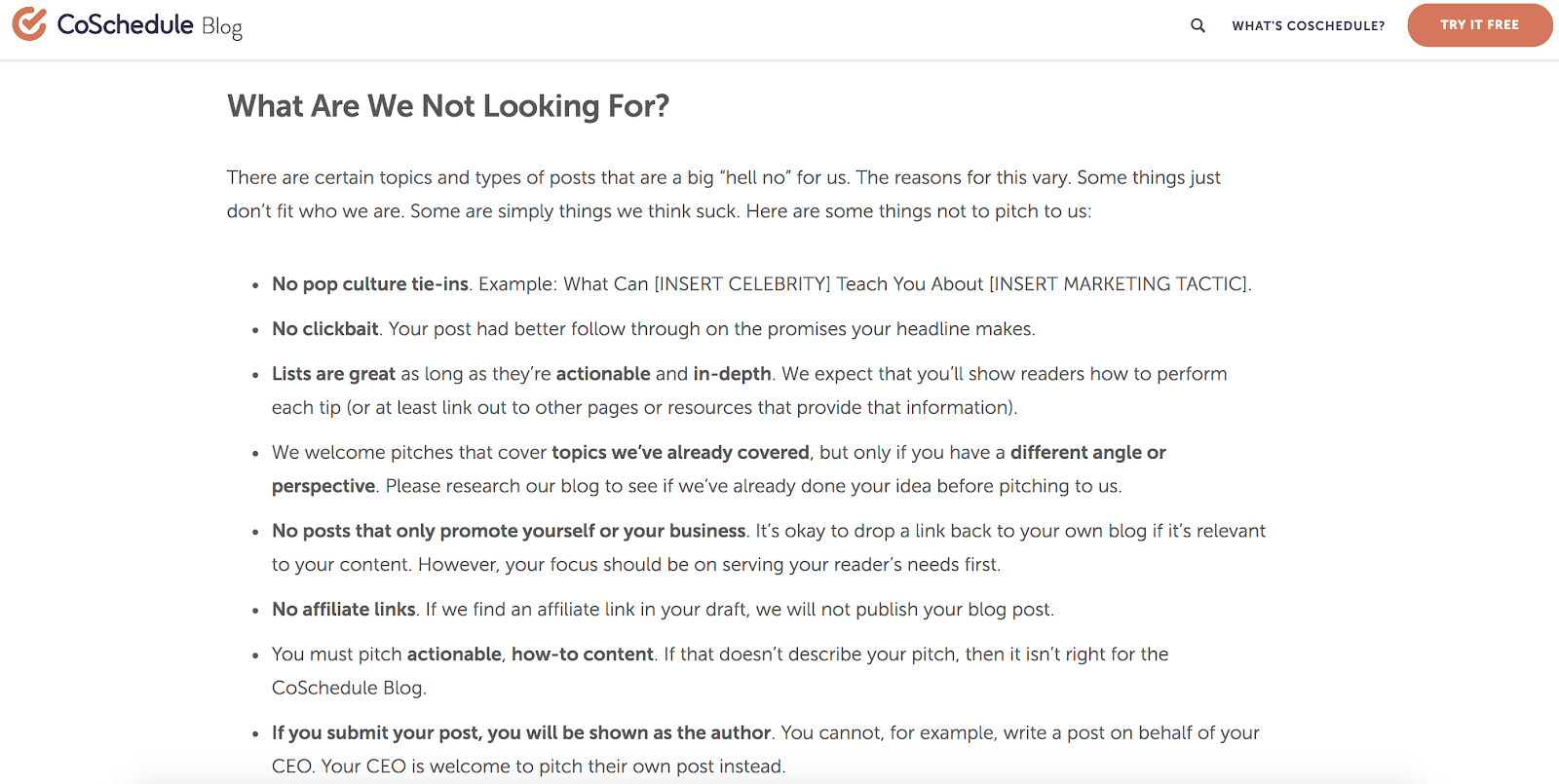 Notice how only the best writers squeeze through their process and end up having their writing published? (Including me ?)
You want to follow the same ethos and never sacrifice quality for quantity.
Google wants to push sites with expertise, knowledge and trust to the top of the ranks. Vet your contributors and if they don’t meet the same E-A-T guidelines, don’t publish their stuff.
It’s really that simple!
Notice how only the best writers squeeze through their process and end up having their writing published? (Including me ?)
You want to follow the same ethos and never sacrifice quality for quantity.
Google wants to push sites with expertise, knowledge and trust to the top of the ranks. Vet your contributors and if they don’t meet the same E-A-T guidelines, don’t publish their stuff.
It’s really that simple!
4. Build Strong Editorial Backlinks
Ah, the one word that makes SEOs rejoice: Backlinks. Us content marketers already know these little hyperlinks play a huge role in any SEO strategy, but your content needs to act as a link-building machine if you want to benefit from this algorithm update. Why? Because links prove credibility--that caters to the T part of the E-A-T algorithm: Trustworthiness. Site owners who’re dishing out backlinks want to point their audience in the way of incredible content. If they point to low-quality sites, it’s their reputation at stake--and their own rankings that will drop. That’s not gonna do them any favors. But site owners who run reputable, powerful websites want to send their audience in the way of great content. Not 500 words of spun content or content stuffed with your keyword in every paragraph--hence why you need to create strong content, and build even stronger backlinks to get in Google’s good books. Follow Moz’s 10x framework, or Backlinko’s skyscraper technique, to build that content. Go above and beyond with your knowledge, educating your customers much better that anyone else can.- Send the URL to other blogs you’ve linked-to (external linking is good for SEO)
- Ask influencers to take part and get them to share with their followers
- Build your own promotion network and ask those people to share your content with their network. (Slack is great for this!)
- Broken link building: Identify a 404 error on your target website, and create a resource to replace it with. Send your URL as a replacement.
- Round-up/resource link building: Search popular round-up/resource pages in your industry, and reach out to the editor asking to get involved.
- Guest posting: Write another piece of supporting content and place it on a popular website, linking back to your original piece.
- Infographic link building: Create an infographic to support your content, and attempt to get it published on industry sites with a link to your content as credit.
Ready to Ace Google’s E-A-T Algorithm?
If you’re not focusing on creating content that’s written by experts, authoritative and from a trustworthy site, you’ll have a hard time on your journey to page one. But it’s easy to boost your organic search traffic when you’re creating what Google, and your target audience, are craving--just like Marie Haynes did:Quality content + strong backlinks = better SEO rankings. And whether you’re just about to ramp-up content production or have a ton of existing content to update, the new E-A-T guidelines are going to get you there.YEAH! Got this incredible email today from a client for whom we did a site review and made a bunch of recommendations. Their main terms were on page 2 and 3. And now they're #2 for their most important keyword.
Improved E-A-T, internal linking and much more. pic.twitter.com/Z7NeXVRtd8 — Marie Haynes (@Marie_Haynes) July 27, 2018
Quality content + strong backlinks = better SEO rankings.
Click To Tweet

